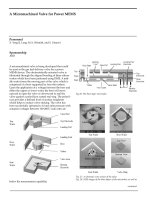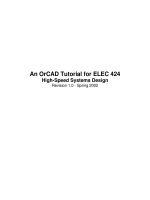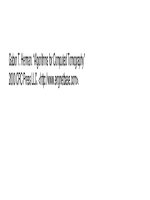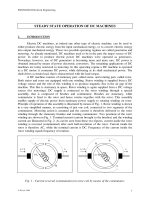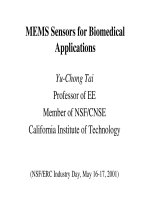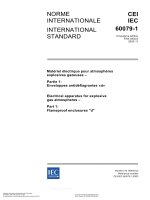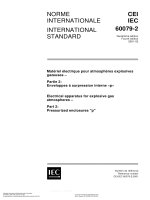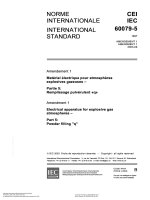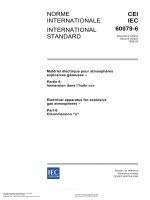ELECTRICAL INSULATION FOR ROTATING MACHINES ppt
Bạn đang xem bản rút gọn của tài liệu. Xem và tải ngay bản đầy đủ của tài liệu tại đây (5.3 MB, 390 trang )
ELECTRICAL INSULATION
FOR ROTATING MACHINES
ffirs.qxd 6/22/2004 3:41 PM Page i
IEEE Press
445 Hoes Lane
Piscataway, NJ 08854
IEEE Press Editorial Board
Stamatios V. Kartalopoulos, Editor in Chief
M. Akay R. J. Herrick M. Padgett
R. J. Baker D. Kirk W. D. Reeve
J. E. Brewer R. Leonardi S. Tewksbury
M. E. El-Hawary M. S. Newman G. Zobrist
Kenneth Moore, Director of Business and Information Services
Catherine Faduska, Senior Acquisitions Editor
Anthony VenGraitis, Project Editor
Other Books in the IEEE Press Series on Power Engineering
Electric Power Systems: Analysis and Control
Fabio Saccomanno
2003 Hardcover 728 pp 0-471-23439-7
Power System Protection
P. M. Anderson
1999 Hardcover 1344 pp 0-7803-3427-2
Understanding Power Quality Problems: Voltage Sags and Interruptions
Math H. J. Bollen
2000 Hardcover 576 pp 0-7803-4713-7
Electric Power Applications of Fuzzy Systems
Edited by M. E. El-Hawary
1998 Hardcover 384 pp 0-7803-1197-3
Principles of Electric Machines with Power Electronic Applications,
Second Edition
M. E. El-Hawary
2002 Hardcover 496 pp 0-471-20812-4
Analysis of Electric Machinery and Drive Systems, Second Edition
Paul C. Krause, Oleg Wasynczuk, and Scott D. Sudhoff
2002 Hardcover 634 pp 0-471-14326-X
ffirs.qxd 6/22/2004 3:41 PM Page ii
ELECTRICAL INSULATION
FOR ROTATING MACHINES
Design, Evaluation, Aging,
Testing, and Repair
GREG C. STONE
EDWARD A. BOULTER
IAN CULBERT
HUSSEIN DHIRANI
A JOHN WILEY & SONS, INC., PUBLICATION
IEEE PRESS
IEEE Press Series on Power Engineering
Mohamed E. El-Hawary, Series Editor
ffirs.qxd 6/22/2004 3:41 PM Page iii
Copyright © 2004 by the Institute of Electrical and Electronics Engineers, Inc. All rights reserved.
Published simultaneously in Canada.
No part of this publication may be reproduced, stored in a retrieval system or transmitted in any form or
by any means, electronic, mechanical, photocopying, recording, scanning or otherwise, except as
permitted under Section 107 or 108 of the 1976 United States Copyright Act, without either the prior
written permission of the Publisher, or authorization through payment of the appropriate per-copy fee to
the Copyright Clearance Center, Inc., 222 Rosewood Drive, Danvers, MA 01923, (978) 750-8400, fax
be addressed to the Permissions Department, John Wiley & Sons, Inc., 111 River Street, Hoboken, NJ
07030, (201) 748-6011, fax (201) 748-6008.
Limit of Liability/Disclaimer of Warranty: While the publisher and author have used their best efforts in
preparing this book, they make no representation or warranties with respect to the accuracy or
completeness of the contents of this book and specifically disclaim any implied warranties of
merchantability or fitness for a particular purpose. No warranty may be created or extended by sales
representatives or written sales materials. The advice and strategies contained herein may not be
suitable for your situation. You should consult with a professional where appropriate. Neither the
publisher nor author shall be liable for any loss of profit or any other commercial damages, including
but not limited to special, incidental, consequential, or other damages.
For general information on our other products and services please contact our Customer Care
Department within the U.S. at 877-762-2974, outside the U.S. at 317-572-3993 or fax 317-572-4002.
Wiley also publishes its books in a variety of electronic formats. Some content that appears in print,
however, may not be available in electronic format.
Library of Congress Cataloging-in-Publication Data is available.
ISBN 0-471-44506-1
Printed in the United States of America.
10987654321
ffirs.qxd 6/22/2004 3:41 PM Page iv
(978) 646-8600, or on the web at www.copyright.com . Requests to the Publisher for permission should
v
CONTENTS
Preface xvii
1 Rotating Machine Insulation Systems 1
1.1 Types of Rotating Machines 1
1.1.1 AC Motors 2
1.1.2 Synchronous Generators 4
1.1.3 Classification by Cooling 6
1.2 Purpose of Windings 7
1.2.1 Stator Winding 7
1.2.2 Insulated Rotor Windings 9
1.2.3 Squirrel Cage Induction Motor Rotor Windings 9
1.3 Types of Stator Winding Construction 9
1.3.1 Random-Wound Stators 10
1.3.2 Form-Wound Stators—Coil Type 10
1.3.3 Form-Wound Stators—Roebel Bar Type 12
1.4 Stator Winding Insulation System Features 12
1.4.1 Strand Insulation 12
1.4.2 Turn Insulation 17
1.4.3 Groundwall Insulation 18
1.4.4 Groundwall Partial Discharge Suppression 20
1.4.5 Groundwall Stress Relief Coatings 24
1.4.6 Mechanical Support in the Slot 27
1.4.7 Mechanical Support in the End-Winding 29
1.4.8 Transposition Insulation 31
1.5 Rotor Winding Insulation System Components 34
1.5.1 Salient Pole Rotor 35
1.5.2 Round Rotors 36
1.5.3 Induction Motor Wound Rotors 38
References 40
2 Evaluating Insulation Materials and Systems 43
2.1 Aging Stresses 44
2.1.1 Thermal Stress 45
ftoc.qxd 6/22/2004 4:02 PM Page v
2.1.2 Electric Stress 46
2.1.3 Ambient Stress (Factors) 47
2.1.4 Mechanical Stress 48
2.1.5 Multiple Stresses 49
2.2 Principles of Accelerated Aging Tests 49
2.2.1 Candidate and Reference Materials/Systems 50
2.2.2 Statistical Variation 50
2.2.3 Failure Indicators 55
2.3 Thermal Endurance Tests 56
2.3.1 Basic Principles 56
2.3.2 Thermal Identification and Classification 57
2.3.3 Insulating Material Thermal Aging Tests 58
2.3.4 Insulation Systems Thermal Aging Tests 58
2.3.5 Future Trends 60
2.4 Electrical Endurance Tests 60
2.4.1 Proprietary Tests for Form-Wound Coils 61
2.4.2 Standardized Test Methods for Form-Wound Coils 62
2.5 Thermal Cycling Tests 63
2.5.1 IEEE Thermal Cycling Test 63
2.5.2 IEC Thermal Cycling Test 64
2.6 Multifactor Stress Testing 65
2.7 Nuclear Environmental Qualification Tests 65
2.7.1 Environmental Qualification (EQ) by Testing 66
2.7.2 Environmental Qualification by Analysis 66
2.7.3 Environmental Qualification by a Combination 67
of Testing and Analysis
2.8 Material Property Tests 67
References 69
3 Historical Development of Insulation Materials and Systems 73
3.1 Natural Materials 74
3.2 Early Synthetics 76
3.3 Plastic Films and Nonwovens 78
3.4 Liquid Synthetic Resins 79
3.4.1 Polyesters 79
3.4.2 Epoxides (Epoxy Resins) 81
3.5 Mica 83
3.5.1 Mica Splittings 83
3.5.2 Mica Paper 84
3.6 Glass Fibers 86
3.7 Laminates 87
3.8 Evolution of Wire and Strand Insulation 88
3.9 Manufacture of Random-Wound Stator Coils 89
3.10 Manufacture of Form-Wound Coils and Bars 89
3.10.1 Early Systems 89
vi
CONTENTS
ftoc.qxd 6/22/2004 4:02 PM Page vi
3.10.2 Asphaltic Mica Systems 90
3.10.3 Individual Coil and Bar Thermoset Systems 90
3.10.4 Global VPI Systems 91
3.11 Wire Transposition Insulation 92
3.12 Insulating Liners, Separators and Sleeving 93
3.12.1 Random-Wound Stators 93
3.12.2 Rotors 93
References 94
4 Stator Winding Insulation Systems in Current Use 95
4.1 Methods of Applying Form-Wound Stator Coil Insulation 97
4.2 Description of Major Trademarked Form-Wound Stator 99
Insulation Systems
4.2.1 Westinghouse Electric Co.:Thermalastic
TM
99
4.2.2 General Electric Co.: Micapals I and II
TM
100
Epoxy Mica Mat
TM
, Micapal HT
TM
, and Hydromat
TM
4.2.3 Alsthom, GEC Alsthom, Alstom Power: Isotenax,
TM
101
Resitherm,
TM
Resiflex,
TM
Resivac
TM,
and Duritenax
TM
4.2.4 Siemens AG, KWU: Micalastic
TM
102
4.2.5 ABB Industrie AG: Micadur
TM
, Micadur Compact,
TM
102
Micapact,
TM
Micarex
TM
4.2.6 Toshiba Corporation: Tosrich,
TM
Tostight I
TM
103
4.2.7 Mitsubishi Electric Corporation 104
4.2.8 Hitachi Ltd.: HiResin,
TM
Hi-Mold,
TM
Super Hi-Resin
TM
104
4.2.9 Summary of Present-Day Insulation Systems 104
4.3 Recent Developments for Form-Wound Insulation Systems 105
4.4 Random-Wound Stator Insulation Systems 107
4.4.1 Magnet Wire Insulation 107
4.4.2 Phase and Ground Insulation 108
4.4.3 Varnish Treatment and Impregnation 108
4.5 Revolutionary Stator Winding Insulation Systems 108
4.5.1 Superconducting Windings 108
4.5.2 PowerFormer
™
109
References 110
5 Rotor Winding Insulation Systems 113
5.1 Rotor Slot and Turn Insulation 114
5.2 Collector Insulation 115
5.3 End-Winding Insulation and Blocking 116
5.4 Retaining Ring Insulation 116
5.5 Direct-Cooled Rotor Insulation 117
6 Core Laminations and Their Insulation 119
6.1 Electromagnetic Materials 119
6.1.1 Magnetic Fields 119
CONTENTS
vii
ftoc.qxd 6/22/2004 4:02 PM Page vii
6.1.2 Ferromagnetism 119
6.1.3 Magnetization Saturation Curve 120
6.1.4 Ferromagnetic Materials 120
6.1.5 Permeability 121
6.1.6 Hysteresis Loop 121
6.1.7 Eddy Current Loss 122
6.1.8 Other Factors Affecting Core Loss 122
6.1.9 Effect of Direction of the Grain 124
6.1.10 Effect of Temperature 124
6.1.11 Effect of Heat Treatment 124
6.1.12 Effect of Impurities and Alloying Elements 124
6.1.13 Silicon/Aluminum Steels 125
6.2 Mill-Applied Insulation 125
6.3 Lamination Punching and Laser Cutting 125
6.4 Annealing and Burr Removal 126
6.5 Enameling or Film Coatings 127
References 127
7 General Principles of Winding Failure, Repair and Rewinding 129
7.1 Failure Processes 129
7.1.1 Relative Failure Rates of Components 131
7.1.2 Factors Affecting Failure Mechanism Predominance 132
7.2 Factors Affecting Repair Decisions 133
7.3 Cutting Out Stator Coils After Failure 134
7.4 Rewinding 134
References 135
8 Stator Failure Mechanisms and Repair 137
8.1 Thermal Deterioration 137
8.1.1 General Process 137
8.1.2 Root Causes 139
8.1.3 Symptoms 140
8.1.4 Remedies 141
8.2 Thermal Cycling 141
8.2.1 General Process 142
8.2.2 Root Causes 144
8.2.3 Symptoms 145
8.2.4 Remedies 145
8.3 Inadequate Impregnation or Dipping 146
8.3.1 General Process 146
8.3.2 Root Causes 146
8.3.3 Symptoms 148
8.3.4 Remedies 148
8.4 Loose Coils in the Slot 148
8.4.1 General Process 148
viii
CONTENTS
ftoc.qxd 6/22/2004 4:02 PM Page viii
8.4.2 Root Causes 149
8.4.3 Symptoms 151
8.4.4 Remedies 152
8.5 Semiconductive Coating Failure 152
8.5.1 General Process 152
8.5.2 Root Causes 153
8.5.3 Symptoms 153
8.5.4 Remedies 154
8.6 Semiconductive/Grading Coating Overlap Failure 155
8.6.1 General Process 155
8.6.2 Root Causes 156
8.6.3 Symptoms 156
8.6.4 Remedies 156
8.7 Repetitive Voltage Surges 157
8.7.1 General Process 158
8.7.2 Root Cause 159
8.7.3 Symptoms 160
8.7.4 Remedies 160
8.8 Contamination (Electrical Tracking) 161
8.8.1 General Process 161
8.8.2 Root Causes 164
8.8.3 Symptoms 164
8.8.4 Remedies 164
8.9 Abrasive Particles 165
8.9.1 General Process 165
8.9.2 Root Causes 165
8.9.3 Symptoms and Remedies 166
8.10 Chemical Attack 166
8.10.1 General Process 166
8.10.2 Root Causes 167
8.10.3 Symptoms 167
8.10.4 Remedies 167
8.11 Inadequate End-Winding Spacing 168
8.11.1 General Process 168
8.11.2 Root Causes 170
8.11.3 Symptoms 170
8.11.4 Remedies 171
8.12 End-Winding Vibration 172
8.12.1 General Process 172
8.12.2 Root Causes 173
8.12.3 Symptoms 174
8.12.4 Remedies 174
8.13 Stator Coolant Water Leaks 175
8.13.1 General Process 175
8.13.2 Root Causes 176
CONTENTS
ix
ftoc.qxd 6/22/2004 4:02 PM Page ix
8.13.3 Symptoms 177
8.13.4 Remedies 177
8.14 Poor Electrical Connections 177
8.14.1 General Process 178
8.14.2 Root Causes 178
8.14.3 Symptoms 178
8.14.4 Remedies 179
References 179
9 Rotor Winding Failure Mechanisms and Repair 181
9.1 Round Rotor Windings 181
9.1.1 Thermal Deterioration 181
9.1.2 Thermal Cycling 183
9.1.3 Abrasion Due To Imbalance or Turning Gear Operation 186
9.1.4 Pollution (Tracking) 187
9.1.5 Repetitive Voltage Surges 188
9.1.6 Centrifugal Force 189
9.1.7 Remedies 191
9.2 Salient Pole Rotor Windings 192
9.2.1 Thermal Aging 192
9.2.2 Thermal Cycling 193
9.2.3 Pollution (Tracking and Moisture Absorption) 194
9.2.4 Abrasive Particles 195
9.2.5 Centrifugal Force 195
9.2.6 Repetitive Voltage Surges 196
9.2.7 Remedies 196
9.3 Wound Induction Rotor Windings 198
9.3.1 Transient Overvoltages 198
9.3.2 Unbalanced Stator Voltages 199
9.3.3 High-Resistance Connections—Bar Lap 199
and Wave Windings
9.3.4 End-Winding Banding Failures 200
9.3.5 Slip Ring Insulation Shorting and Grounding 200
9.3.6 Remedies 201
9.4 Squirrel Cage Induction Rotor Windings 202
9.4.1 Thermal 202
9.4.2 Cyclic Mechanical Stressing 203
9.4.3 Poor Design/Manufacture 206
9.4.4 Repairs 208
References 209
10 Core Lamination Insulation Failure and Repair 211
10.1 Thermal Deterioration 211
10.1.1 General Process 212
10.1.2 Root Causes 212
x
CONTENTS
ftoc.qxd 6/22/2004 4:02 PM Page x
10.1.3 Common Symptoms 213
10.2 Electrical Degradation 214
10.2.1 General Process 214
10.2.2 Root Causes 214
10.2.3 Common Symptoms 217
10.3 Mechanical Degradation 218
10.3.1 General Process 218
10.3.2 Root Causes 218
10.3.3 Symptoms 221
10.4 Failures Due To Manufacturing Defects 221
10.4.1 General Process 221
10.4.2 Root Causes 222
10.4.3 Symptoms 222
10.5 Core Repairs 222
10.5.1 Loose Cores 223
10.5.2 Core Insulation Shorting 223
10.5.3 Core Damage Due to Winding Electrical Faults 224
10.5.4 False Tooth 225
10.5.5 Cracked Through-Bolt Insulation 225
References 225
11 General Principles of Testing and Monitoring 227
11.1 Purpose of Testing and Monitoring 227
11.1.1 Assessing Winding Condition and Remaining 227
Winding Life
11.1.2 Prioritizing Maintenance 228
11.1.3 Commissioning and Warranty Testing 228
11.1.4 Determining Root Cause of Failure 228
11.2 Off-Line Testing Versus On-Line Monitoring 229
11.3 Role of Visual Inspections 230
11.4 Expert Systems to Convert Data into Information 230
11.4.1 Off-Line Expert Systems 231
11.4.2 On-Line Expert Systems 231
References 233
12 Off-Line Rotor and Stator Winding Tests 235
12.1 Insulation Resistance and Polarization Index 235
12.1.1 Purpose and Theory 238
12.1.2 Test Method 240
12.1.3 Interpretation 241
12.2 DC Hipot 243
12.2.1 Purpose and Theory 243
12.2.2 Test Method 243
12.2.3 Interpretation 245
12.3 DC Conductivity Test 246
CONTENTS
xi
ftoc.qxd 6/22/2004 4:02 PM Page xi
12.3.1 Purpose and Theory 246
12.3.2 Test Method 246
12.3.3 Interpretation 247
12.4 AC Hipot Test 247
12.4.1 Purpose and Theory 248
12.4.2 Test Method 249
12.4.3 Interpretation 249
12.5 Capacitance Test 249
12.5.1 Purpose and Theory 250
12.5.2 Test Method 250
12.5.3 Interpretation 251
12.6 Capacitance Tip-Up Test 252
12.6.1 Purpose and Theory 252
12.6.2 Test Method 253
12.6.3 Interpretation 253
12.7 Capacitive Impedance For Motor Stators 254
12.8 Dissipation (or Power) Factor Test 254
12.8.1 Purpose and Theory 255
12.8.2 Test Method 255
12.8.3 Interpretation 257
12.9 Power (Dissipation) Factor Tip-Up Test 257
12.9.1 Purpose and Theory 257
12.9.2 Test Method 258
12.9.3 Interpretation 259
12.10 Off-Line Partial Discharge Test 259
12.10.1 Purpose and Theory 259
12.10.2 Test Method 261
12.10.3 Interpretation 262
12.11 Partial Discharge Probe Tests 263
12.11.1 Purpose and Theory 263
12.11.2 Test Method 264
12.11.3 Interpretation 264
12.12 Stator Surge Comparison Test 265
12.12.1 Purpose and Theory 265
12.12.2 Test Method 267
12.12.3 Interpretation 267
12.13 Inductive Impedance Test 268
12.14 Semiconductive Coating Contact Resistance Test 269
12.14.1 Purpose and Theory 269
12.14.2 Test Method 269
12.14.3 Interpretation 270
12.15 Conductor Coolant Tube Resistance 270
12.15.1 Purpose and Test Method 270
12.16 Stator Wedge Tap Test 270
12.16.1 Purpose and Theory 271
xii
CONTENTS
ftoc.qxd 6/22/2004 4:02 PM Page xii
12.16.2 Test Method 271
12.16.3 Interpretation 271
12.17 Slot Side Clearance Test 272
12.17.1 Purpose and Theory 272
12.17.2 Test Method 272
12.17.3 Interpretation 272
12.18 Stator Slot Radial Clearance Test 273
12.18.1 Purpose and Theory 273
12.18.2 Test Method 273
12.18.3 Interpretation 273
12.19 Stator End-Winding Resonance Test 273
12.19.1 Purpose and Theory 274
12.19.2 Test Method 274
12.19.3 Interpretation 274
12.20 Rotor Voltage Drop Test 274
12.20.1 Purpose and Theory 275
12.20.2 Test Method 275
12.20.3 Interpretation 275
12.21 Rotor RSO and Surge Test 275
12.21.1 Purpose and Theory 275
12.21.2 Test Method 276
12.21.3 Interpretation 276
12.22 Rotor Growler Test 277
12.22.1 Purpose and Theory 277
12.22.2 Test Method 277
12.22.3 Interpretation 278
12.23 Rotor Fluorescent Dye Penetrant 278
12.23.1 Purpose and Theory 278
12.23.2 Test Method and Interpretation 278
12.24 Rotor Rated Flux Test 278
12.24.1 Purpose and Theory 278
12.24.2 Test Method 278
12.24.3 Interpretation 279
12.25 Rotor Single-Phase Rotation Test 279
12.25.1 Purpose and Theory 279
12.25.2 Test Method 279
12.25.3 Interpretation 279
12.26 Stator Blackout Test 279
12.26.1 Purpose and Theory 280
12.26.2 Test Method 280
12.26.3 Interpretation 280
12.27 Stator Pressure and Vacuum Decay Test 281
12.27.1 Purpose and Theory 281
12.27.2 Test Methods and Interpretation 281
References 282
CONTENTS
xiii
ftoc.qxd 6/22/2004 4:02 PM Page xiii
13 In-Service Monitoring of Stator and Rotor Windings 285
13.1 Thermal Monitoring 286
13.1.1 Stator Winding Point Sensors 286
13.1.2 Rotor Winding Sensors 288
13.1.3 Data Acquisition and Interpretation 288
13.1.4 Thermography 289
13.2 Condition Monitors and Tagging Compounds 290
13.2.1 Monitoring Principles 291
13.2.2 Interpretation 292
13.3 Ozone 293
13.3.1 Monitoring Principles 293
13.3.2 Interpretation 294
13.4 On-Line Partial Discharge Monitor 295
13.4.1 Monitoring Principles 295
13.4.2 Interpretation 302
13.5 End-Winding Vibration Monitor 307
13.5.1 Monitoring Principles 307
13.5.2 Data Acquisition and Interpretation 308
13.6 Synchronous Rotor Flux Monitor 308
13.6.1 Monitoring Principles 308
13.6.2 Data Acquisition and Interpretation 310
13.7 Current Signature Analysis 311
13.7.1 Monitoring Principles 311
13.7.2 Data Acquisition 313
13.7.3 Interpretation 314
13.8 Air Gap Monitoring for Salient Pole Machines 315
13.8.1 Monitoring Principles 315
13.9 Voltage Surge Monitor 316
13.9.1 Monitoring Principles 316
13.9.2 Interpretation 316
13.10 Bearing Vibration Monitor 317
13.10.1 Induction Motor Monitoring 317
13.10.2 Synchronous Machine Monitoring 318
References 319
14 Core Testing 321
14.1 Knife Test 321
14.1.1 Purpose and Theory 321
14.1.2 Test Method 322
14.1.3 Interpretation 322
14.2 Rated Flux Test 323
14.2.1 Purpose and Theory 323
14.2.2 Test Method 324
14.2.3 Interpretation 328
14.3 Core Loss Test 328
xiv
CONTENTS
ftoc.qxd 6/22/2004 4:02 PM Page xiv
14.3.1 Purpose and Theory 328
14.3.2 Test Method 328
14.3.3 Interpretation 328
14.4 Low Core Flux Test (EL-CID) 329
14.4.1 Purpose and Theory 329
14.4.2 Test Method 330
14.4.3 Interpretation 331
References 332
15 Acceptance and Site Testing of New Windings 333
15.1 Stator Windings Insulation System Prequalification Tests 333
15.1.1 Power Factor Tip-Up Test 333
15.1.2 Partial Discharge Test 334
15.1.3 Impulse (Surge) Test 335
15.1.4 Voltage Endurance Test 335
15.1.5 Thermal Cycling Test 337
15.1.6 Thermal Classification Tests 338
15.2 Stator Winding Insulation System Factory and On-Site Tests 339
15.2.1 Insulation Resistance and Polarization Index Tests 339
15.2.2 AC and DC Hipot Tests 340
15.2.3 Impulse (Surge) Tests 341
15.2.4 Strand-to-Strand Test 342
15.2.5 Power Factor Tip-Up Test 342
15.2.6 Partial Discharge Test 343
15.2.7 Capacitance Test 343
15.2.8 Semiconductive Coating Test 344
15.2.9 Wedge Tap 344
15.3 Factory and On-Site Tests for Rotor Windings 345
15.3.1 Tests Applicable to All Insulated Windings 345
15.3.2 Round-Rotor Synchronous Machine Windings 346
15.3.3 Salient Pole Synchronous Machine Windings 347
15.3.4 Wound Induction Rotor Windings 347
15.3.5 Squirrel Cage Rotor Windings 347
15.4 Core Insulation Factory and On-Site Tests 348
15.4.1 Core Tightness Test 348
15.4.2 Rated Flux Test 348
15.4.3 EL-CID Test 349
References 350
16 Maintenance Strategies 351
16.1 Maintenance and Inspection Options 351
16.1.1 Breakdown or Corrective Maintenance 352
16.1.2 Time-Based or Preventative Maintenance 352
16.1.3 Condition-Based or Predictive Maintenance 354
16.1.4 Inspections 355
CONTENTS
xv
ftoc.qxd 6/22/2004 4:02 PM Page xv
16.2 Maintenance Strategies for Various Machine Types and 357
Applications
16.2.1 Turbogenerators 357
16.2.2 Salient Pole Generators and Motors 359
16.2.3 Squirrel Cage and Wound-Rotor Induction Motors 361
Index 365
About the Authors 371
xvi
CONTENTS
ftoc.qxd 6/22/2004 4:02 PM Page xvi
xvii
PREFACE
This book arose out of the conviction that both designers and users of large motors
and generators would appreciate a single reference work about the electrical insula-
tion systems used in rotating machines. We also wanted to document how and why
the insulation systems in current use came to be. Since rotating machine insulation
is not the most glamorous field of study in the engineering world, it is sometimes
treated as an afterthought. The result has been a gradual loss of knowledge as inno-
vators in the field have retired, with few new people specializing in it. We hope that
the archiving of the information in this book will slow this gradual loss of knowl-
edge and be a useful starting point for future innovations.
This book is unique in that two of the authors (Alan Boulter and Ian Culbert)
have a machine design background, whereas the other two have experience as pri-
marily users of machines. With luck, both users and manufacturers of machines can
find their interests represented here.
Collectively, three of us (Greg Stone, Ian Culbert, and Hussein Dhirani) want to
thank Ontario Hydro (now Ontario Power Generation) for enabling us to become
specialists in this field. It seems that the current business climate enables few engi-
neers to become as specialized as we were allowed to be. We would also like to
thank John Lyles, Joe Kapler, and Mo Kurtz, all former employees of Ontario Hy-
dro, who taught us much of what we know. EPRI, and Jan Stein in particular, are
acknowledged for allowing the three of us to have a “dry run” at this book when
they sponsored the writing of a handbook in the 1980s.
We thank Resi Lloyd, who worked valiantly to put a consistent style on the vari-
ous chapters, created many of the figures, and brought the book together.
Hussein Dhirani thanks his family for allowing him to sneak away to the office
on some weekends to work on the book on the dubious pretext of better productivi-
ty. Hussein is grateful for the generosity of the many who shared their knowledge,
from tradesmen working on generators, to designers poring over drawings, to staff
in sister utilities discussing common problems, to supplier organizations explaining
the intricacies of their insulation systems design. The understanding and support of
Derek Sawyer and Bill Wallace at Ontario Power Generation is particularly appre-
ciated.
fpref.qxd 6/22/2004 4:06 PM Page xvii
Ian Culbert thanks Ontario Power Generation for allowing him to participate in a
number of internal and EPRI projects from which he gained much of the informa-
tion he contributed to this book. He also appreciates the opportunities his former
employers Reliance Electric and Parsons Peebles gave him to learn how to design,
test, and troubleshoot motors.
Finally, Greg Stone wants to thank his original partners at Iris Power Engineer-
ing—Blake Lloyd, Steve Campbell, and Resi Lloyd—for allowing his attention to
wander from day-to-day business matters to something as esoteric as contributing
to a book. Of course, Greg’s wife, Judy Allan, is thanked because she never did
question the premise that most folks use vacations for writing books and papers.
G
REG
C. S
TONE
E
DWARD
A. B
OULTER
I
AN
C
ULBERT
H
USSEIN
D
HIRANI
Toronto, Ontario, Canada
October 2003
xviii
PREFACE
fpref.qxd 6/22/2004 4:06 PM Page xviii
Electrical Insulation for Rotating Machines. By Stone, Boulter, Culbert, and Dhirani 1
ISBN 0-471-44506-1 © 2004 Institute of Electrical and Electronics Engineers
CHAPTER 1
ROTATING MACHINE
INSULATION SYSTEMS
In the hundred years since motors and generators were invented, a vast range of electrical
machine types have been created. In many cases, different companies called the same type of
machine or the same component by completely different names. Therefore, to avoid confu-
sion, before a detailed description of motor and generator insulation systems can be given, it
is prudent to identify and describe the types of electrical machines that are discussed in this
book. The main components in a machine, as well as the winding subcomponents, are identi-
fied and their purposes described.
Although this book concentrates on machines rated at 1 kW or more, much of the infor-
mation on insulation system design, failure, and testing can be applied to smaller machines,
linear motors, servomotors, etc. However, these latter machines types will not be discussed
explicitly.
1.1 TYPES OF ROTATING MACHINES
Electrical machines rated at about 1 HP or 1 kW and above are classified into two broad cat-
egories: (1) motors, which convert electrical energy into mechanical energy (usually rotating
torque) and (2) generators (also called alternators), which convert mechanical energy into
electrical energy. In addition, there is another machine called a synchronous condenser that is
a specialized generator/motor generating reactive power. Consult any general book on elec-
trical machines for a more extensive description of machines and how they work [1.1, 1.2,
1.3].
Motors or generators can be either AC or DC, that is, they can use/produce alternating
current or direct current. In a motor, the DC machine has the advantage that its output rota-
tional speed can be easily changed. Thus, DC motors and generators were widely used in in-
dustry in the past. However, with variable speed motors now easily made by combining an
c01.qxd 6/22/2004 4:25 PM Page 1
AC motor with an electronic “inverter-fed drive” (IFD), DC motors in the 100’s of kW range
and above are becoming less common.
Machines are also classified according to the type of cooling used. They can be directly or
indirectly cooled, using air, hydrogen, and/or water as a cooling medium.
This book concentrates on AC induction and synchronous motors, as well as synchronous
generators. Other types of machines exist, but these motors and generators constitute the vast
majority of electrical machines rated more than 1 kW presently used around the world.
1.1.1 AC Motors
Nearly all AC motors have a single-phase (for motors less than about 1 kW) or three-phase
stator winding through which the input current flows. For AC motors, the stator is also called
the armature. AC motors are usually classified according to the type of rotor winding. The
rotor winding is also known as a field winding in most types of machines. A discussion of
each type of AC motor follows.
Squirrel Cage Induction (SCI) Motor (Figure 1.1). The rotor produces a magnetic field
by transformer-like AC induction from the stator (armature) winding. This is by far the most
common type of AC motor made, with millions manufactured every year. SCI motors can
range in size from a fraction of a horsepower motor (< 1 kW) to tens of thousands of horse-
power (greater than 30 MW). The predominance of the squirrel cage induction motor is at-
tributed to the simplicity and ruggedness of the rotor. In an SCI motor, the speed of the rotor
is usually 1% or so slower than the “synchronous” speed of the rotating magnetic field in the
air gap created by the stator winding. Thus, the rotor speed “slips” behind the speed of the air
gap magnetic flux [1.1, 1.2]. The SCI motor is used for almost every conceivable application,
including fluid pumping, fans, conveyor systems, grinding, mixing, and power tool opera-
tion.
Wound Rotor Induction Motor. The rotor is wound with insulated wire and the leads
are brought off the rotor via slip rings. In operation, a current is induced into the rotor from
the stator, just as for an SCI motor. However, in the wound rotor machine it is possible to
limit the current in the rotor winding by means of an external resistance or slip-energy recov-
ery system. This permits some control of the rotor speed. Wound rotor induction motors are
relatively rare due to the extra maintenance required for the slip rings. IFD SCI motors are
often a more reliable, cheaper alternative.
Synchronous Motor. This motor has a direct current flowing through the rotor (field)
winding. The current creates a DC magnetic field, which interacts with the rotating mag-
netic field from the stator, causing the rotor to spin. The speed of the rotor is exactly relat-
ed to the frequency of the AC current supplied to the stator winding (50 or 60 Hz). There
is no “slip.” The speed of the rotor depends on the number of rotor pole pairs ( a pole pair
contains one north and one south pole) times the AC frequency. There are two main ways
of obtaining a DC current in the rotor. The oldest method, still popular, is to feed current
onto the rotor by means of two slip rings (one positive, one negative). Alternatively, the
“brushless” method uses a DC winding mounted on the stator to induce a current in an aux-
iliary three-phase winding mounted on the rotor to generate AC current, which is rectified
(by “rotating” diodes) to DC. Synchronous motors require a small “pony motor” to run the
rotor up to near synchronous speed. Alternatively, an SCI type of winding on the rotor can
be used to drive the motor up to speed, before DC current is permitted to flow in the main
2
ROTATING MACHINE INSULATING SYSTEMS
c01.qxd 6/22/2004 4:25 PM Page 2
rotor winding. This winding is referred to as an amortisseur or damper winding. Because of
the more complicated rotor and additional components, synchronous motors tend to be re-
stricted to very large motors today (greater than 10 MW) or very slow speed motors. The
advantage of a synchronous motor is that it usually requires less “inrush” current on start-
up in comparison to a SCI motor, and the speed is more constant. Also, the operating en-
ergy costs are lower since, by adjusting the rotor DC current, one can improve the power
factor of the motor, reducing the need for reactive power and thus the AC supply current.
Refer to the section on synchronous generators below for further subdivision of the types
of synchronous motor rotors. Two-pole synchronous motors use round rotors, as described
in Section 1.1.2.
Permanent Magnet Motors. These motors have rotors made of a special permanently
magnetized material. That is, no DC or AC current flows in the rotor, and there is no rotor
winding. In the past, such motors were always rated at < 50 HP, since they can be hard to
1.1 TYPES OF ROTATING MACHINES
3
Figure 1.1. Photograph of a SCI rotor being lowered into the squirrel cage induction motor stator.
c01.qxd 6/22/2004 4:26 PM Page 3
shut down. However, some large permanent magnet motors have been recently used in ma-
rine applications, due to their simplicity.
1.1.2 Synchronous Generators
Although induction generators do exist, particularly in wind turbine generators, they are rela-
tively rare compared to synchronous generators. Virtually all generators used by electrical
utilities are of the synchronous type. In synchronous generators, DC current flows through
the rotor (field) winding, which creates a magnetic field from the rotor. At the same time, the
rotor is spun by a steam turbine (using fossil or nuclear fuel), gas turbine, diesel engine or, a
hydroelectric turbine. The spinning DC field from the rotor induces current to flow in the sta-
tor (armature) winding. As for motors, the following types of synchronous generators are de-
termined by the design of the rotor, which is primarily a function of the speed of the driving
turbine.
Round Rotor Generators (Figure 1.2). Also known as cylindrical rotor machines, round
rotors are most common in high-speed machines, that is, machines in which the rotor re-
volves at about 1000 rpm or more. Where the electrical system operates at 60 Hz, the rotor
speed is usually either 1800 rpm or 3600 rpm. The relatively smooth surface of the rotor re-
duces “windage” losses, that is, the energy lost to moving the air (or other gas) around in the
air gap between the rotor and the stator—the fan effect. This loss can be substantial at high
speeds in the presence of protuberances from the rotor surface. The smooth cylindrical shape
also lends itself to a more robust structure under the high centrifugal forces that occur in
high-speed machines. Round rotor generators, sometimes called “turbogenerators,” are usu-
ally driven by steam turbines or gas turbines (jet engines). Turbogenerators using round ro-
4
ROTATING MACHINE INSULATING SYSTEMS
Figure 1.2. Phototgraph of a small round rotor. The retaining rings are at each end of the rotor body.
c01.qxd 6/22/2004 4:26 PM Page 4
tors have been made in excess of 1500 MW. (1000 MW is a typical load for a city of 500,000
people in an industrialized country). Such a machine may be 10 m in length and about 5 m in
diameter, with a rotor on the order of 1.5 m in diameter. Such large generators almost always
have a horizontally mounted rotor and are hydrogen-cooled (see Section 1.1.3).
Salient Pole Generators (Figure 1.3). Salient pole rotors usually have individual magnet-
ic field poles that are mounted on a rim, with the rim in turn fastened to the rotor shaft by a
“spider”—a set of spokes. Since the magnetic field poles protrude from the rim with spaces
between the poles, the salient pole rotor creates considerable air turbulence in the air gap be-
tween the rotor and the stator as the rotor rotates, resulting in a relatively high windage loss.
However, since the rotational speed is usually significantly less than 1000 rpm, the loss is
considered moderate. Salient pole machines typically are used with hydraulic turbines, which
have a relatively low rpm (the higher the penstock, i.e., the larger the fall of the water, the
faster the speed). To generate 50 or 60 Hz current in the stator, a large number of field poles
are needed (recall that the generated AC frequency is the number of pole pairs times the rotor
speed in revolutions per second). Fifty pole pairs are not uncommon on a hydrogenerator,
compared to one or two pole pairs on a turbogenerator. Such a large number of pole pairs re-
quires a large rotor diameter in order to mount all the poles. Hydrogenerators have been
made up to about 800 MW. The rotor in a large hydrogenerator is almost always vertically
mounted, and may be more than 10 m in diameter.
Pump/Storage Generator. This is a special type of salient pole machine. It is used to
pump water into an upper reservoir during times of low electricity demand. Then, at times of
high demand for electricity, the water is allowed to flow from the upper reservoir to the low-
er reservoir, where the machine operates in reverse as a generator. The reversal of the ma-
1.1 TYPES OF ROTATING MACHINES
5
Figure 1.3. Photograph of a salient pole rotor for a large, low-speed motor. (Courtesy TECO-Westing-
house.)
c01.qxd 6/22/2004 4:26 PM Page 5
chine from the pump to generate mode is commonly accomplished by changing the connec-
tions on the machine’s stator winding to reverse rotor direction. In a few cases, the pitch of
the hydraulic turbine blades is changed. In the pump motor mode, the rotor can come up to
speed by using a SCI-type winding on the rotor (referred to as an amortisseur or damper
winding), resulting in a large inrush current, or by using a “pony” motor. If the former is
used, the machine is often energized by an inverter-fed drive (IFD) that gradually increases
the rotor speed by slowly increasing the AC frequency to the stator. Since the speed is typi-
cally less than a few hundred rpm, the rotor is of the salient pole type. Pump storage units
have been made up to 500 MW.
1.1.3 Classification by Cooling
Another important means of classifying machines is by the type of cooling medium they use:
water, air, and/or hydrogen gas. One of the main heat sources in electrical machines is the
DC or AC current flowing through the stator and rotor windings. These are usually called I
2
R
losses, since the heat generated is proportional to the current squared times the resistance of
the conductors (almost always copper in stator windings, but sometimes aluminum in SCI ro-
tors). There are other sources of heat: magnetic core losses, windage losses, and eddy current
losses. All these losses cause the temperature of the windings to rise. Unless this heat is re-
moved, the winding insulation deteriorates and the machine fails due to a short circuit.
Indirect Air Cooling. Motors and modern generators rated less than about 100 MVA are
almost always cooled by air flowing over the rotor and stator. This is called indirect cooling
since the winding conductors are not directly in contact with the cooling air due to the pres-
ence of electrical insulation on the windings. The air itself may be continuously drawn in
from the environment, that is, not recirculated. Such machines are termed open-ventilated,
although there may be some effort to prevent particulates (sand, coal dust, pollution, etc.)
and/or moisture from entering the machine using filtering and indirect paths for drawing in
the air. These open-ventilated machines are referred to as weather-protected or WP.
A second means of obtaining cool air is to totally enclose the machine and recirculate air
via a heat exchanger. This is often needed for motors that are exposed to the elements. The re-
circulated air is most often cooled by an air-to-water heat exchanger in large machines, or
cooled by the outside air via radiating metal fins in small motors or a tube-type cooler in large
ones. Either a separate blower motor or a fan mounted on the motor shaft circulates the air. IEC
and NEMA standards describe the various types of cooling methods in detail [1.4, 1.5].
Although old, small generators may be open-ventilated, the vast majority of hydrogenera-
tors and turbogenerators (rated less than about 50 MVA) have recirculated air flowing
through the machine. Virtually all hydrogenerators use recirculated air, with the air often
cooled by air-to-water heat exchangers. For turbogenerators rated up to a few hundred
megawatts, recirculated air is now the most common form of cooling.
Indirect Hydrogen Cooling. Almost all large turbogenerators use recirculated hydrogen
as the cooling gas. This is because the smaller and lighter hydrogen molecule results in a
lower windage loss and better heat transfer than air. It is then cost effective to use hydrogen
in spite of the extra expense involved, due to the few percent gain in efficiency. The dividing
line for when to use hydrogen cooling is constantly changing. In the 1990s, there was a defi-
nite trend to reserve hydrogen cooling for machines rated more than 300 MVA, whereas in
the past, hydrogen cooling was sometimes used on steam and gas turbine generators as small
as 50 MVA [1.6, 1.7].
6
ROTATING MACHINE INSULATING SYSTEMS
c01.qxd 6/22/2004 4:26 PM Page 6
